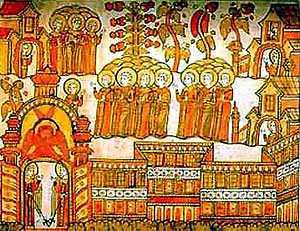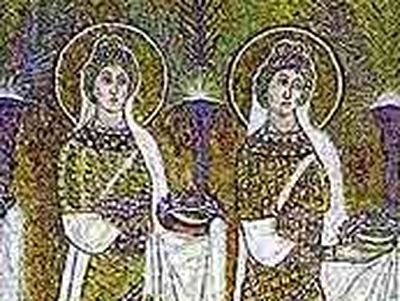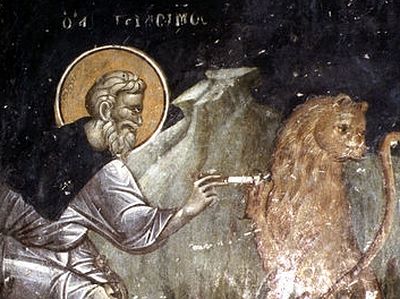
The apocrypha belongs the apocalyptical genre of visions, miraculous ascensions to heaven and journeys to the other world. The main topic of the apocrypha is graceful tie of the Orthodox monastery with the shrines of Palestine and the Garden of Eden (Ancient Russian cosmology, SPb, 2004). As is well known, in the Orthodox worship certain most important places of the promised land are symbolized, where like in paradise the earth and heaven miraculously get in touch (Lev Lebedev, Theology of Russian land as of image of the promised land of the Kingdom of Heaven. The Millenary of the Baptism of Russia: International ecclesiastical conference "Theology and spirituality", Moscow, May 11-16, 1987, M., 1989).
After foundation of a monastery and the All-Merciful Saviour church hegumen Agapius prayed to the Lord asking to reveal him, what monastic ministry meant and for the sake of what monks left the world? Responding to the prayer of Agapius the Lord allowed him to leave the monastery and set out on a pilgrimage. Though the revelation about paradise was not mentioned as the main goal of Agapius’ prayer and journey, the Lord reminded him, how close the life of monks in the monastery was to the life of the first people in Eden. The Saviour also pointed out the danger of stormy waves of the worldly sea beyond the walls of the monastery. On the seashore Christ appeared to Agapius in the image of a child steering a ship (ship is a symbol of the church building and the Church). The child asked Agapius: "Are you well? What are you doing here in the sea reaches? Do not you know that wild beasts abound here, and they will eat you up, Agapius?" Agapius replied to the small child: "Who are you, and where do not know me from?" The child answered: "Agapius, do not you know me? Was not it me among your neighbours near the monastery? My Father was also there. And my brothers too - do not they learn from you in your monastery?" Father’s and Son’s neighbourhood with the monastery meant that monastic life brought the ascetics closer to the heavenly fellowship with God, and the monks fulfilling God’s will were brothers to Christ (Mt. 12. 50).
The small child asked Agapius: "What is your way? Where are you going to?" Agapius answered: "I do not know what should I call the place where I am going. God my Lord is my way."
Having tested the spiritual motives of Agapius’ search Christ invited Agapius to cross the sea with his ship. He commanded Agapius to sleep for a while. When Agapius fell asleep, "the child commanded great men to take Agapius over the sea. The men put Agapius down on the ground and became invisible".
Brought by angels to the paradise threshold Agapius beheld "God’s glory in the seventh heaven". The text is aimed to present sensual realities of the narration as a prototype of what is going on in the spiritual world. Among abundant fruit-bearing plants, birds and flowers Agapius saw the Lord Jesus Christ and the Apostles, cherubs and seraphs. Walking from the threshold to the altar in the Heavenly Jerusalem "he saw light, which was seven times brighter than the earthly light". Agapius described a sky-high cross and a paradise spring. According to the other version of the apocrypha in the city "there was an image of God and Saviour our Lord Jesus Christ, great and wonderful". In the center of the Holy of Holies there were grapes and a meal with celestial bread. Walls and cells of the Heavenly Jerusalem were adorned with precious stones.
It is not by chance that in the Revelation of St. John the Divine the heavenly altar is called "Jerusalem", though "the New one" "coming down from God out of heaven" (Rev. 21. 2), for the shrines of the earthly Jerusalem correspond to their heavenly archetypes. The miraculous "walk of Agapius to the Lord’s places" ended with a pilgrimage to the holy city of Jerusalem where Agapius healed multitudes of the sick. Different versions of the apocrypha emphasize that it was Patriarch of Jerusalem who rendered to the whole Church "The lay of our father Saint Agapius about a man who leaves his home, takes his cross and follows Christ as the Holy Gospel teaches".
The structure of the Heavenly Jerusalem as Agapius saw it points out to the identity of paradise with the Orthodox monastery. After returning from paradise the beholder of God’s mysteries took up his abode in a monastery, and the description of the monastery literally copies the description of the Heavenly Jerusalem (sea, high walls, entrance, cell, bed): "And the angel said to Agaipius: "Go along the sea and you will find a place prepared for you. Settle down there and write about your vision, which you saw in the Lord’s places". Agapius walked along the sea for many days and found high walls on the seashore. When he approached them he saw doors in the walls. He entered and walked upstairs and saw a room arranged within those walls and a bed already made." The last phrase about the blessed repose of Agapius in reclusion unequivocally calls the Orthodox monastery "paradise": "Blessed Agapius dwelt in the cell for forty years living on the piece of bread given to him by prophet Elijah. Agapius ended his life in paradise, gave his soul to the Lord praising the Most-Pure Trinity, the Father and the Son and the Holy Spirit ever and unto ages of ages. Amen”.
In the comments to the text "The Walk of Agapius to Paradise" V.V.Milkov noted: "The walk to paradise should be understood not in literal sense, but allegorically - as the attainment of heavenly freedom on the way of monastic asceticism. Emphatic details of the almost novelistic narration about the walk to paradise are perceived as a metaphor of monastic asceticism, a special way of service of the Lord. According to this type of mystical and ascetical symbolism paradise turns out to be a symbol of the monastery. The narration points out that the hermit ended his life "in paradise". This key phrase reveals the conceptual implication of the whole apocrypha, which cannot be understood in a different way in the context of such conclusion. Allegorical heaven turns out to be unambiguously identical to the earthly heaven - the monastery. The system of parables has found its completion here" (V.V.Milkov, Ancient Russian apocrypha, SPb, 1999).



